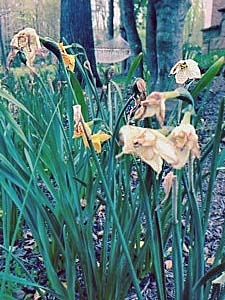My Spring Bulbs Are Sprung Out
Spring bulbs’ leaves making you crazy? Get over it
by Jo Anna Natale, Fairfax Master Gardener
Daffodils, tulips and other spring-blooming bulbs have two phases: there is the flowering phase, highly anticipated and rightly adored; and then there is the after-flowering phase with its long, long, long-lingering leaves.
In this latter stage, too many of us lose our cool prematurely and practice horticultural torture. We braid, rubber band, or tie down that foliage – if not chop it to a nub – so it won’t distract from the next blooming beauty in the garden. Although these leaf-taming techniques might make you feel better, you are doing the bulbs no favor and are, in many cases, compromising or even killing next year’s show.
Instead, practice patience. Spring-flowering bulbs depend on the leafy, post-flowering phase to prepare for next year’s blooms. Remember the botany chapter of your high school biology textbook: Plants need leaves to soak up energy from the sun and carbon dioxide from the air so they can produce food for themselves. (Photosynthesis, anyone?) If you diminish or remove leaves prematurely, this crucial process gets cut short. Deprived of food, the bulbs will weaken and yield skimpier flowers next March, April and May—and that deprives you of the garden display you’ll be dreaming about all winter.

Fading daffodils. Let the foliage die back naturally to ensure a good show of flowers next year.
As a rule, it is safe to remove foliage from spring-blooming bulbs when the leaves become yellow and withered. Destroy – don’t compost – the leaves, just in case they have picked up disease. As for stems, it is best to remove them right after the flowers fade so as to prevent seeds from forming. Seed production tends to steal food from the bulb.
If you want to move the bulbs, dig them up with faded leaves intact and plenty of dirt surrounding the bulb. Heel them in elsewhere in the garden or in a pot and then replant in the fall in your new favorite location. If you choose the elsewhere-in-the garden plan, make sure you mark the spot, so you can find the bulbs later on.
You’ll want to thin bulbs such as daffodils, hyacinths, and crocuses if those plantings have grown too tightly packed. Carefully dig them up with the withered leaves intact, shake off the soil, then gently separate the bulbs before replanting the heartiest-looking ones.
In gardening, it pays to remember that what you do one season strongly impacts what happens in others. This year, instead of dissing the greenery, show some respect to the leaves spring-blooming bulbs leave behind. They have work to do before they die, and the spring blossoms you enjoy next year will be their legacy.